Living in dry and drought-prone areas can be difficult for gardeners and those who adore plants. However, living in dry conditions or experiencing a drought does not mean you must forgo having plants. There are several dozens of plants that thrive in dry conditions and can tolerate drought. Some of these plants prefer to have little water.
For example, succulents are a perfect plant for those who are either too busy to maintain their plants or those living in dry conditions. Succulents require little water and can thrive in even the most sun-kissed areas with little rainfall. Succulents originated in Mexico and Africa, making them ideal plants to choose for the garden in dry and drought-prone locations.
While succulents are a popular choice, they are not the only choice. From grasses to shrubs and flowers, there are dozens of more options for gardeners who wish to have a resilient garden capable of enduring droughts. Let’s take a look at some of our favorite plants that are drought tolerant, and perfectly suited for dry climate gardens.
Adam’s Needle
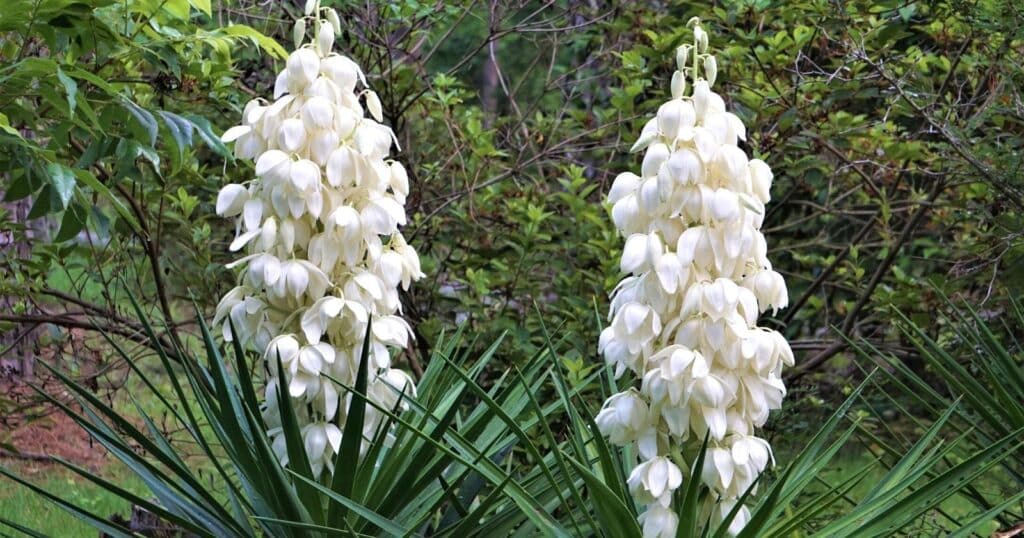
Scientific Name: Yucca filamentosa
- Plant Type: Perennial
- Origin: Southeastern North America
- Plant Size: 8 Feet
- Sunlight Needs: Full Sun
- Hardiness Zone: 4 Through 10
Adam’s Needle is a shrub that blooms twice a year and offers a stunning green color to any garden or landscape. This plant grows slowly and is a distant relative of cacti and succulents. This plant is given its name due to its needles.
After growing for three to five years, Adam’s Needle plants may begin sprouting flowers that bloom between the spring and summer months. These flowers can add nearly four feet to the plant’s height.
Agave
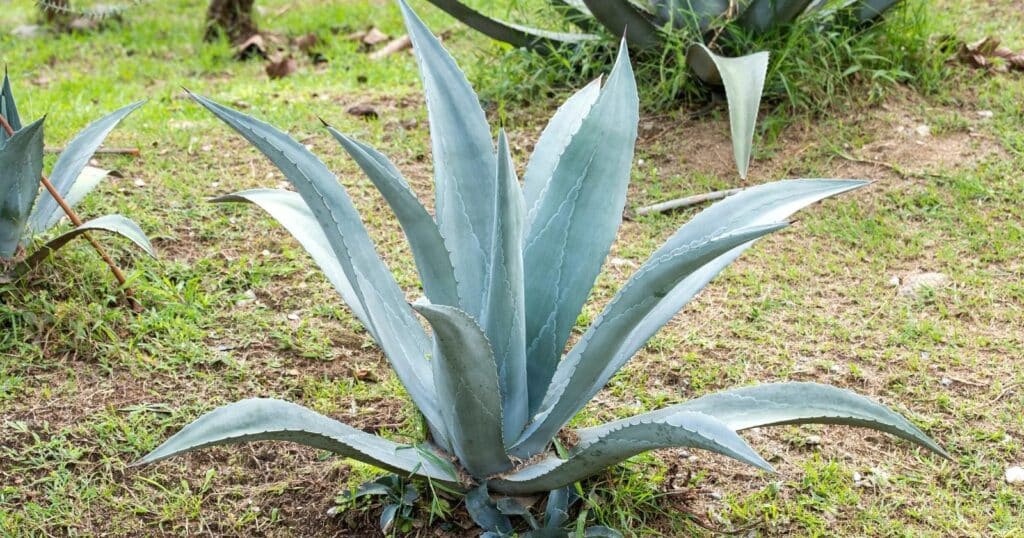
Scientific Name: Agave tequilana
- Plant Type: Perennial
- Origin: North and South America
- Plant Size: Up To 10 Feet
- Sunlight Needs: Full Sun
- Hardiness Zone: 8 And 9
Agave plants are succulents and have large, sharp leaves that contain fluid. There are many varieties of the Agave plant, many coming in different sizes and colors. Although this plant shares a name with sweet nectar, this plant is toxic and should never be ingested by humans or animals.
This plant does best in dry conditions and in a location that is arid or semiarid.
Artemisia
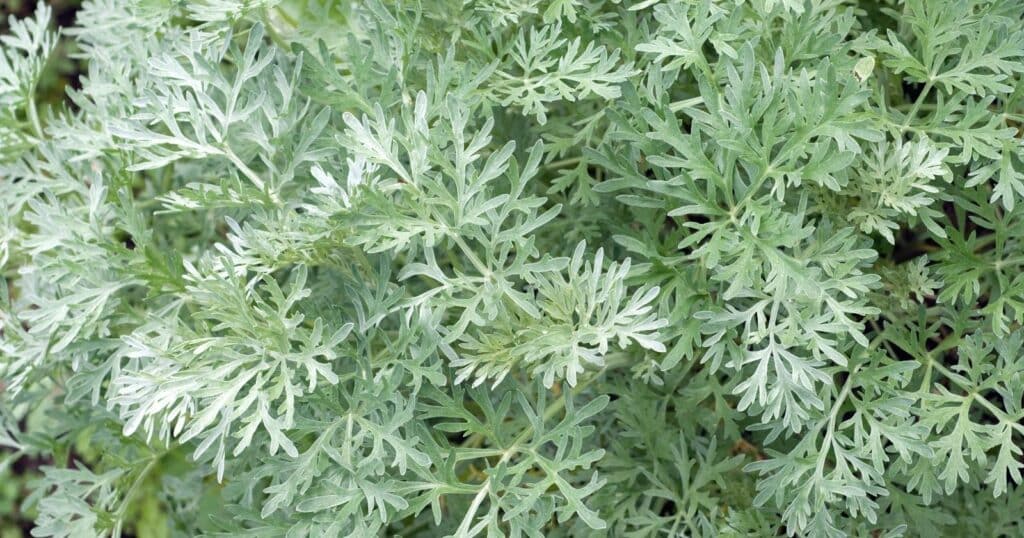
Scientific Name: Artemisia
- Plant Type: Perennial
- Origin: Asia
- Plant Size: 3 Feet
- Sunlight Needs: Full Sun
- Hardiness Zone: 4 Through 9
Artemisia is a stunning green plant with branches and leaves reminiscent of a Christmas tree. This plant looks like a bush or shrub and grows white flowers from the top of its stalks. The topmost part of an artemisia plant insulates and protects the roots and plant below, but the plant will still need well-drained soil and plenty of space to accommodate its wide size.
An artemisia plant can grow three feet wide and offers stunning green, white, and pale colors for your home and garden.
Blanket Flower
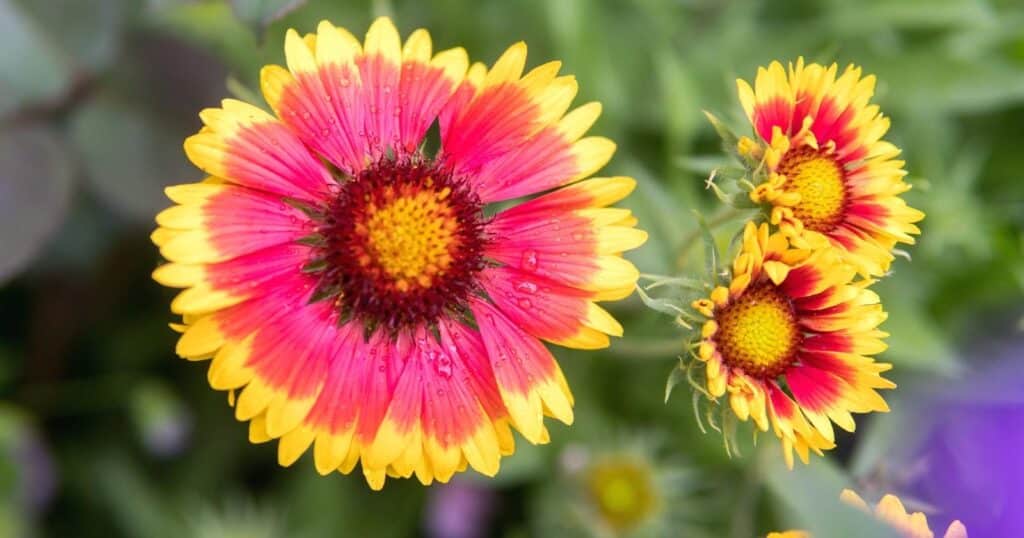
Scientific Name: Gaillardia
- Plant Type: Perennial
- Origin: Western North America
- Plant Size: 18 Inches
- Sunlight Needs: Full Sun
- Hardiness Zone: 3 Through 9
Although this plant is easy to grow, it is also quick to die. This perennial grows with rich and stunning colors and offers a vine that spreads quickly, covering a lot of ground. This plant can grow tall in difficult conditions. Soil for a Blanket Flower plant should be well-drained but does not have to have many nutrients.
A Blanket Flower plant is a hybrid of wildflowers native to North America.
Blue Oat Grass
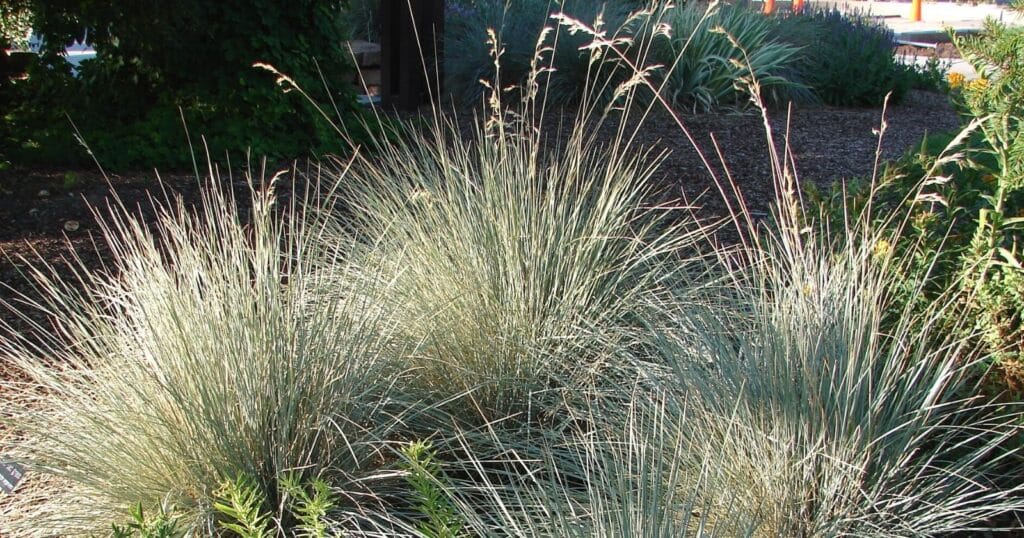
Scientific Name: Helictotrichon sempervirens
- Plant Type: Perennial
- Origin: Central and Southwest Europe
- Plant Size: 2 Feet
- Sunlight Needs: Full Sun
- Hardiness Zone: 4 Through 9
As its name may suggest, Blue Oat Grass has a blueish-green hue. Blue Oat Grass is a ball-shaped plant that can cover nearly two feet of coverage and offer pops of blue color to any front lawn or rock garden. This plant is heat resistant and can survive well without much water and in dry weather.
Many public places use Blue Oat Grass in their landscaping because this plant is low maintenance and does not require much care.
Bougainvillea

Scientific Name: Bougainvillea glabra
- Plant Type: Perennial
- Origin: South America
- Plant Size: Up To 40 Feet
- Sunlight Needs: Full Sun
- Hardiness Zone: 9 Through 11
This vining plant is ideal on a trellis or several trellises as it can grow about 40 feet with proper care. Bougainvillea plants are well-suited for dry conditions and are drought tolerant, making them ideal for locations with little access to water.
Bougainvillea can be laced through trellises or pergolas to make for a stunning display of rich purple and magenta colors.
Boxwood
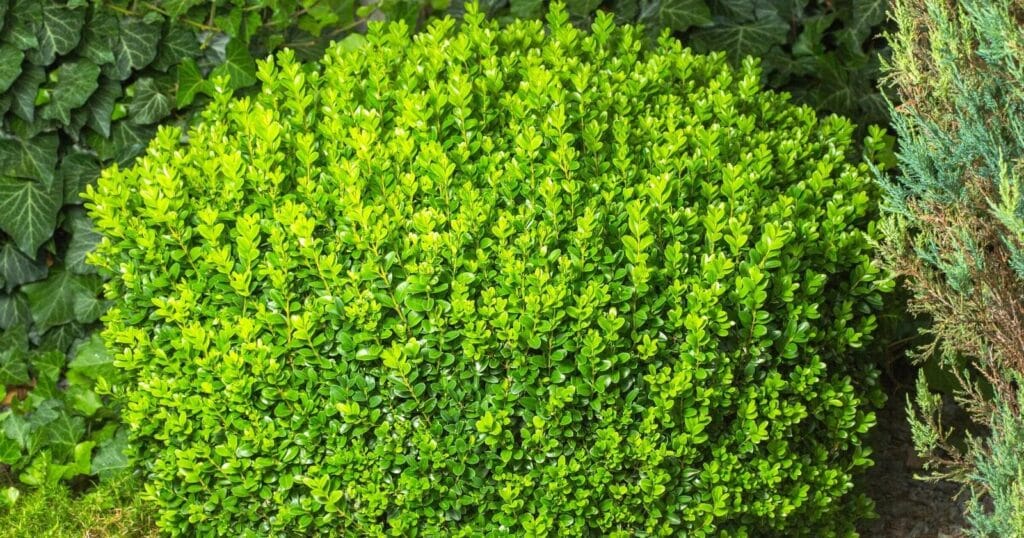
Scientific Name: Buxus sempervirens
- Plant Type: Year-Round Shrub
- Origin: Europe and Asia
- Plant Size: 20 Inches
- Sunlight Needs: Part Shade
- Hardiness Zone: 5 Through 9
Boxwood plants are iconic for outside homes and are often used to add vibrant green colors to front lawns. Boxwood plants are perfect to use as hedges on a front lawn and can be cut into a square if desired. Boxwoods can tolerate drought but also need partial shade.
These ornamental shrubs can also be kept in containers, as long as the container and soil are well-draining to prevent any root diseases.
California Poppy
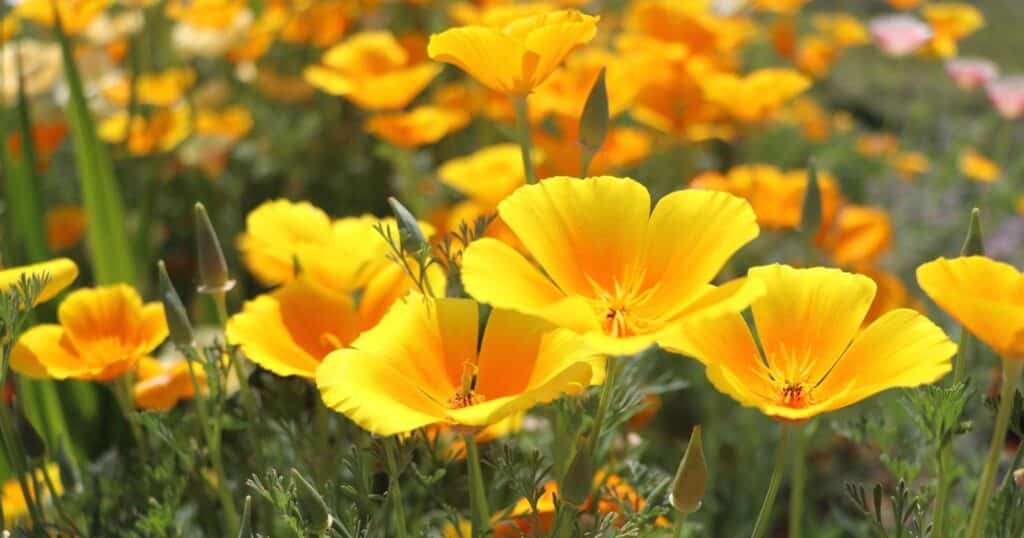
Scientific Name: Eschscholzia californica
- Plant Type: Perennial
- Origin: North America
- Plant Size: 12 Inches
- Sunlight Needs: Full Sun
- Hardiness Zone: 8 Through 10
California Poppy plants need well-drained soil because their roots do not like to sit in standing water. Root rot can have subtle signs and may be difficult to identify, making well-drained soil a necessary component of preventing disease and fungal disasters.
California poppy plants, as their name suggests, can be found in California most often. However, this plant can also be found in Oregon and alongside the Northwest coast of the United States. These stunning flowers are usually yellow and orange and easy to spot.
Catmint
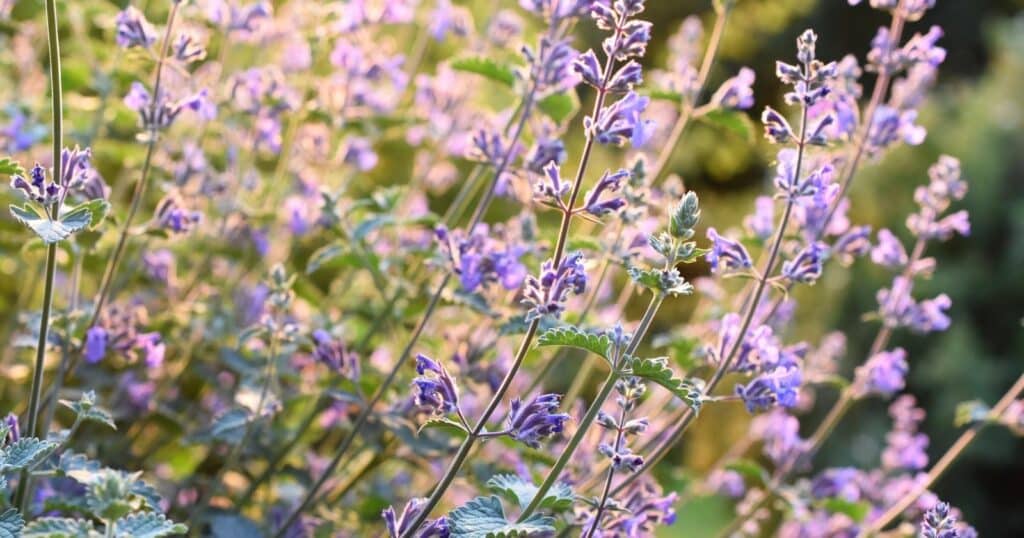
Scientific Name: Nepeta x faassenii
- Plant Type: Perennial
- Origin: Europe, Middle East, Asia
- Plant Size: 24 Inches
- Sunlight Needs: Full Sun
- Hardiness Zone: 3 Through 8
Catmint is a beautiful, lavender-colored bush that prefers dry conditions. Although new sprouts should be well-watered until their roots are established, these plants can fend off droughts and thrive in even the most difficult conditions.
Some hybrids of a catmint plant are smaller and more ideal for compact areas, but most varieties are large and wide. Catmint can be as tall as 24 inches high and 24 inches wide. Although this plant was first discovered in Europe, the Middle East, and Asia, catmint can grow healthy and strong roots in New Zealand and North America.
Coneflower
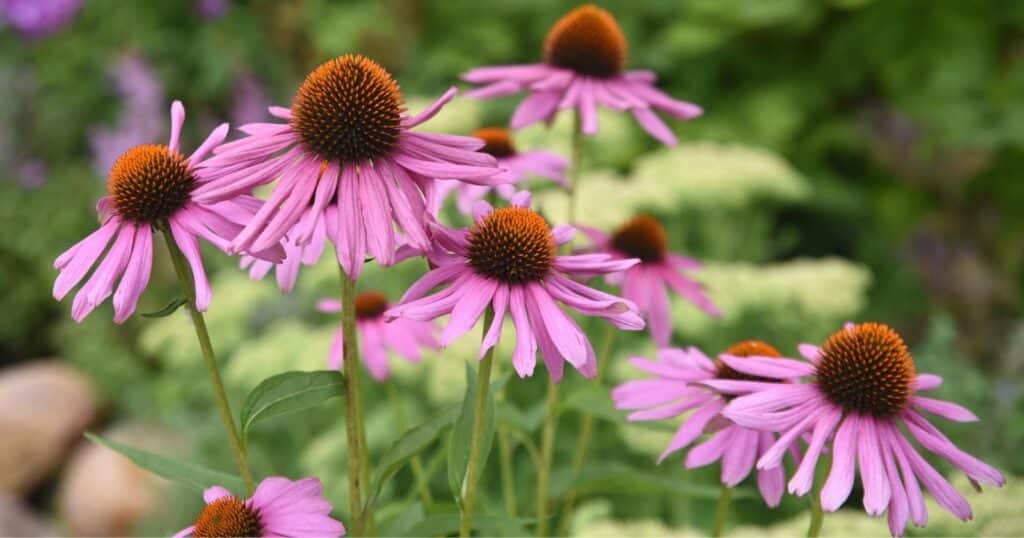
Scientific Name: Echinacea
- Plant Type: Perennial
- Origin: North America
- Plant Size: 4 Feet
- Sunlight Needs: Full Sun
- Hardiness Zone: 5 Through 8
Coneflowers are perfect for decorative ideas and sprucing up a home. Coneflowers come in pink, orange, yellow, red, and magenta colors. This flower has little purpose other than looking nice and offering a garden a pop of color. However, they are heat resistant and tolerate droughts well.
As long as your coneflower has well-drained soil, your coneflowers will likely survive even the most difficult conditions during a drought or dry climate.
Creeping Phlox
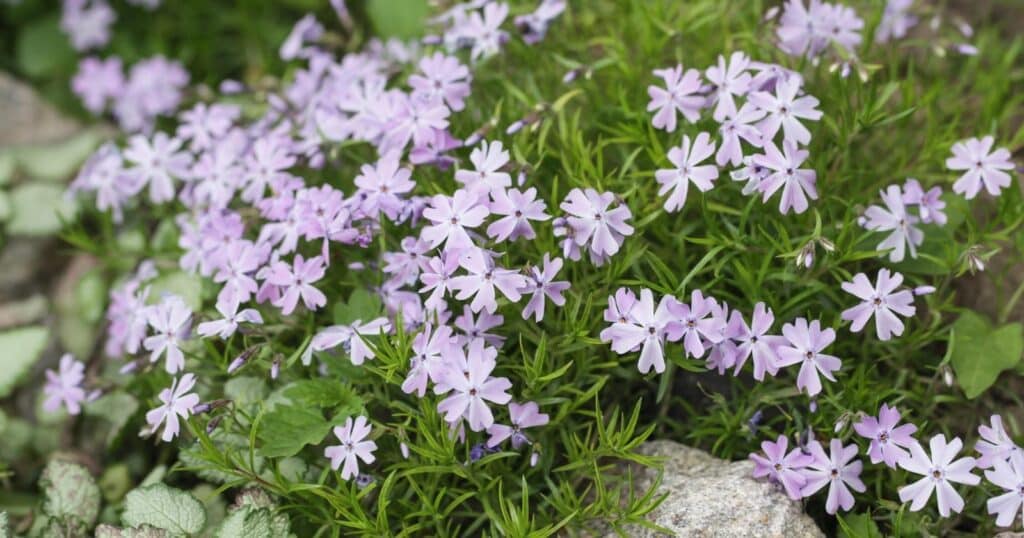
Scientific Name: Phlox stolonifera
- Plant Type: Perennial
- Origin: Eastern and Central North America
- Plant Size: 8 Inches
- Sunlight Needs: Full Sun
- Hardiness Zone: 3 Through 9
While a Creeping Phlox plant is not very tall, measuring only eight inches high, it can spread over a large area. One Creeping Phlox plant can cover up to two feet of coverage. This plant can come in varying shades of purple, from light to vibrant and deep magenta.
The Creeping Phlox plant is ideal for bracketing walkways and adding a pop of color to a garden. It can also offer contrasting colors to rock gardens.
Feather Reed Grass
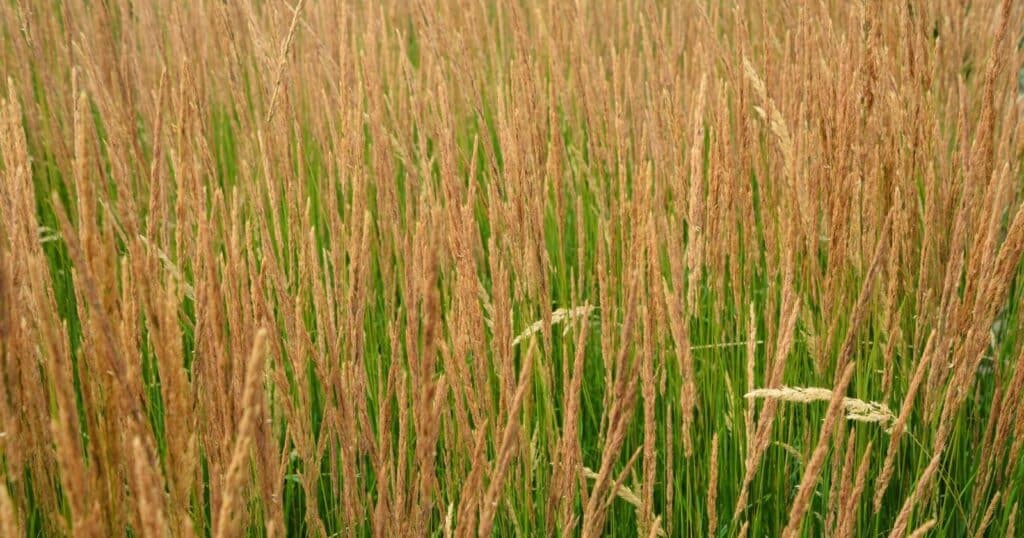
Scientific Name: Calamagrostis x acutiflora
- Plant Type: Perennial
- Origin: Europe and Asia
- Plant Size: 60 Inches
- Sunlight Needs: Full Sun
- Hardiness Zone: 4 Through 9
Feather Reed Grass is a hybrid between two other types of grasses. This grass hybrid will grow a pink or purple colored flower. While this plant requires moist soil, its roots can retain moisture without much watering.
This plant will survive in a drought, however, regardless of the lack of water. Additionally, Feather Reed Grass is tall enough to provide its roots with shade and keep them safe. Feather Reed Grass does best in dry conditions.
Golden Stonecrop
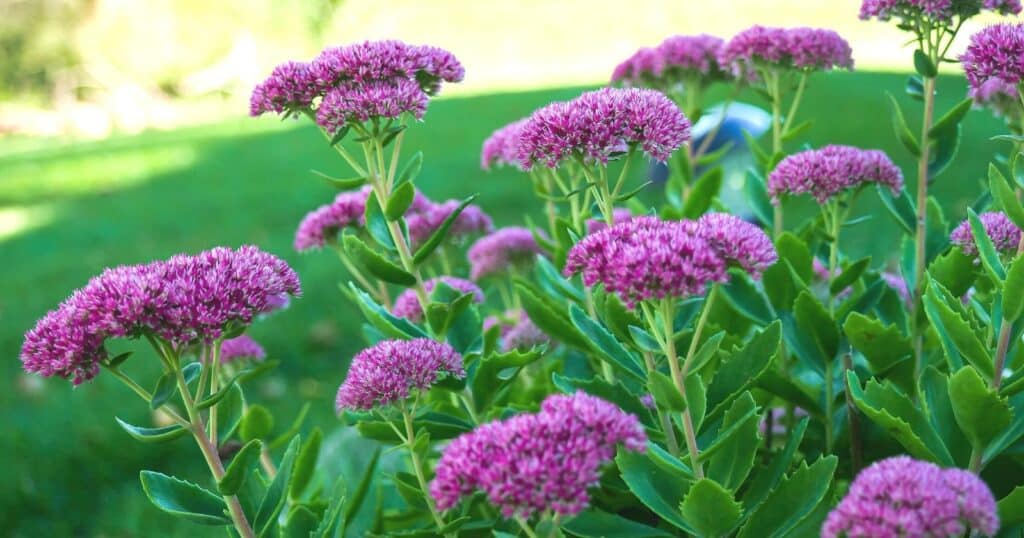
Scientific Name: Sedum
- Plant Type: Perennial
- Origin: Africa and South America
- Plant Size: 24 Inches
- Sunlight Needs: Partial Shade
- Hardiness Zone: 3 Through 11
There are about 600 variations of the Golden Stonecrop, but they all thrive in temperate and tropical zones. These plants are most notable for creeping up on stones and getting plenty of sunlight on the surface. Sometimes, Golden Stonecrops can grow pink, yellow, purple, red, and white flowers.
A Golden Stonecrop is a succulent and ideal for rock gardens and rock walls. They can also be used to edge gardens and create stunning visual appeal.
Hyssop
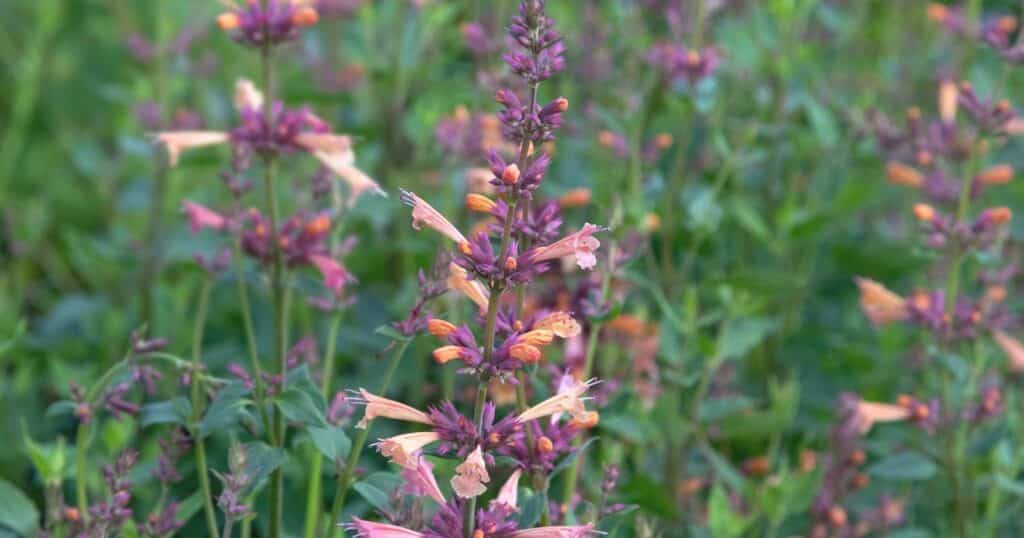
Scientific Name: Agastache aurantiaca
- Plant Type: Perennial
- Origin: Asia and North America
- Plant Size: 4 Feet
- Sunlight Needs: Full Sun
- Hardiness Zone: 4 Through 9
This herbaceous herb is within the mint family and is often grown because of the fragrance of its leaves and flowers. A Hyssop can have a bitter taste when eaten raw but is often added to drinks and food to add flavor and boost the taste.
This plant is characterized by small stems that crop out with oval leaves that grow in pairs, like that of a sunflowers seedling. Flowers on this plant are often blue, violet, magenta, red, or pale white.
Juniper
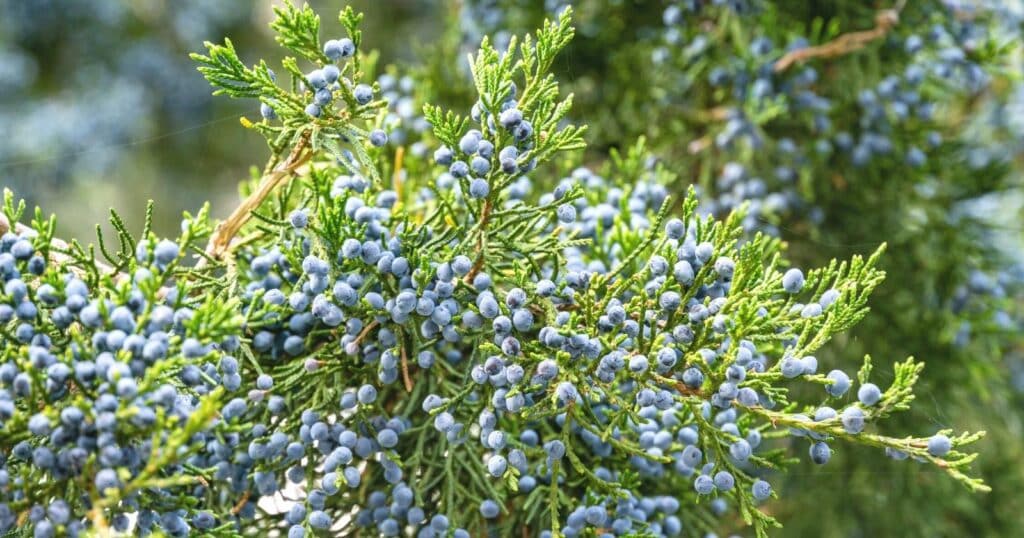
Scientific Name: Juniperus
- Plant Type: Perennial
- Origin: Europe, Asia, Africa, and North America
- Plant Size: Up To 130 Feet
- Sunlight Needs: Full Sun
- Hardiness Zone: 4 Through 8
A Juniper plant is resistant to heat and is ideal for drought-prone areas. Additionally, a Juniper plant is disease-resistant and insect-resistant. A Juniper plant is a perfect addition to homes rife with pests and insects or one where deers are common since they do not attract deers.
Lamb’s Ear
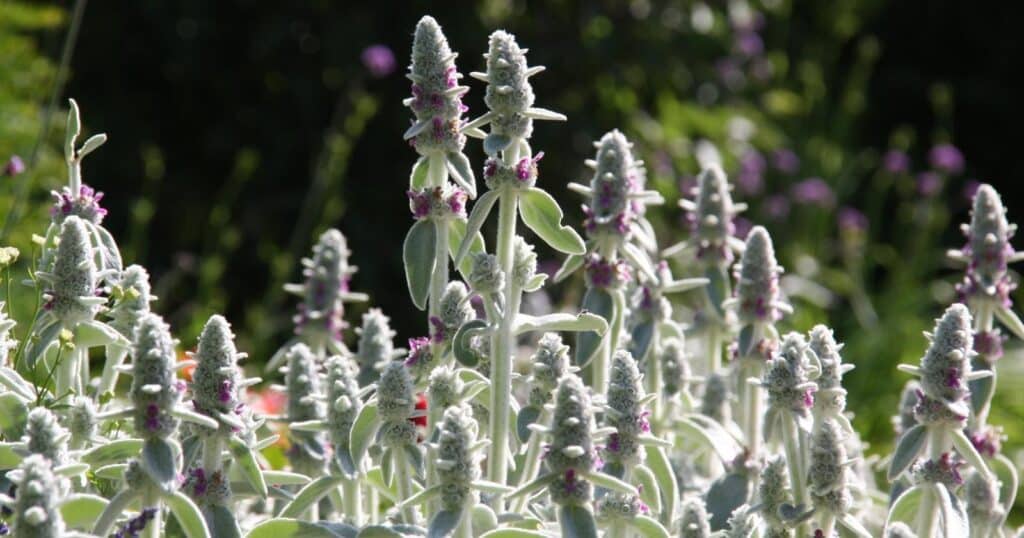
Scientific Name: Stachys byzantina
- Plant Type: Perennial
- Origin: Middle East
- Plant Size: 18 Inches
- Sunlight Needs: Full Sun
- Hardiness Zone: 4 Through 8
Lamb’s Ear is a hairy and velvet-like green plant that gets its name from the shape of its leaves. Lamb’s Ear plants need well-draining soil and do not like to be wet or moist, and will thrive in full sunlight or dry areas.
This plant is known to have cropped up in the Middle East centuries ago, near Turkey and Iran. However, other experts claim that this plant may have originated in Europe and spread through the Middle East afterward.
Lantana
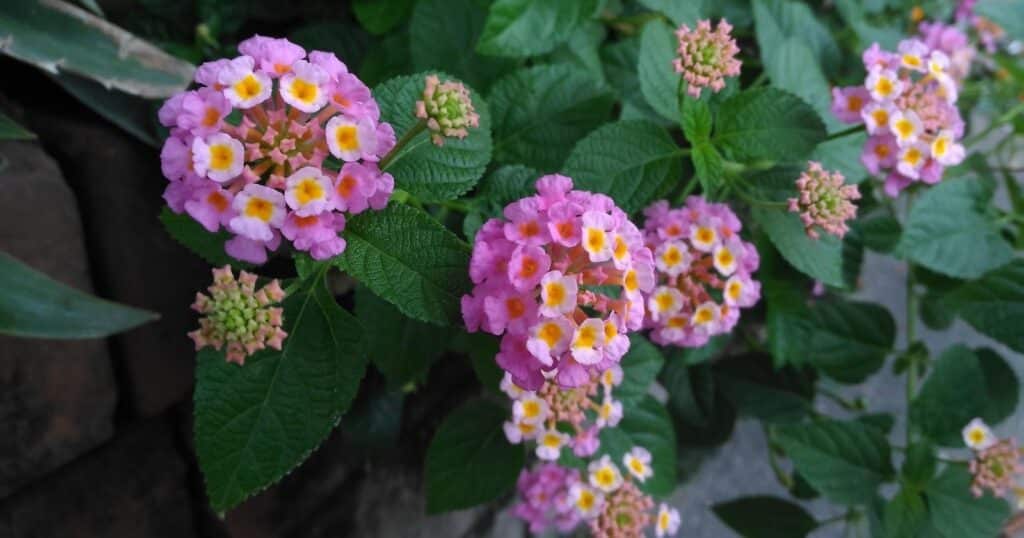
Scientific Name: Lantana camara
- Plant Type: Perennial
- Origin: Americas and Africa
- Plant Size: 6 Feet
- Sunlight Needs: Full Sun
- Hardiness Zone: Nine Through 11
Lantana plants are unique because they vine and expand from their branches, and cover other areas. These plants are ideal for outdoor containers, hanging pots, or plots of land that you would like to see completely covered in beautiful flowers and green vines.
Although this plant can be large, it can be kept in a smaller container to inhibit growth and keep your lantana rather small. Lantana plants can be kept as annuals in colder climates, but they will not return as the seasons change, as they will in warmer climates.
Lavender
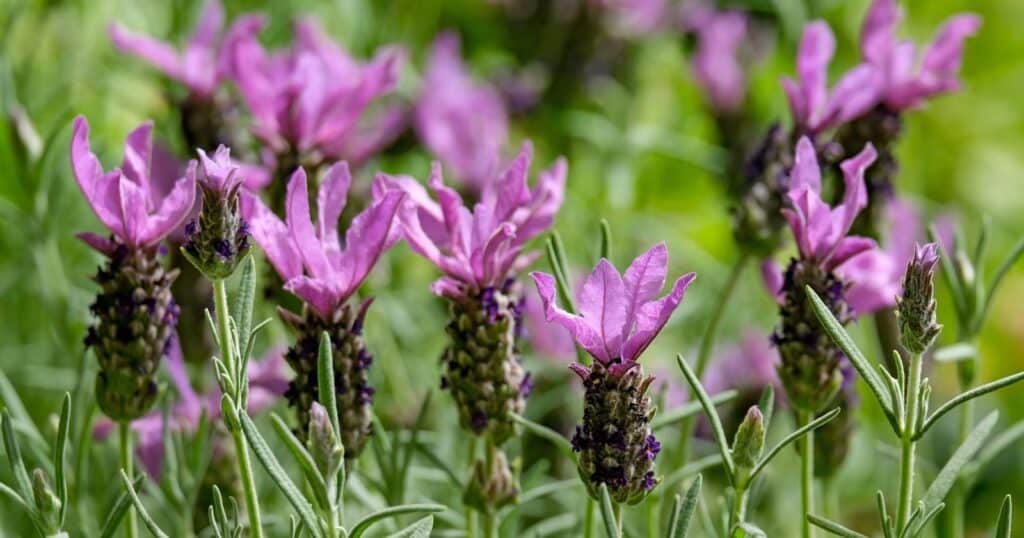
Scientific Name: Lavandula
- Plant Type: Perennial
- Origin: Western Europe and the Mediterranean
- Plant Size: 3 Feet
- Sunlight Needs: Full Sun
- Hardiness Zone: 5 Through 9
Lavender is a fragrant herb that grows stunning and vibrant purple flowers. This plant has been used for health and beauty purposes since the ancient days of Rome, where lavender was used as a bathing addition. Additionally, lavender can be used to make an essential oil that is often infused in perfumes, beauty products, and soaps.
Lavender fields are popular tourist destinations, especially in France. Tourists can smell the lavender, walk through the fields, and enjoy the velvet touch of the flowering stalks.
Lavender plants need full sun to thrive and are the perfect plants for large plots since they can survive with little watering.
Licorice Plant
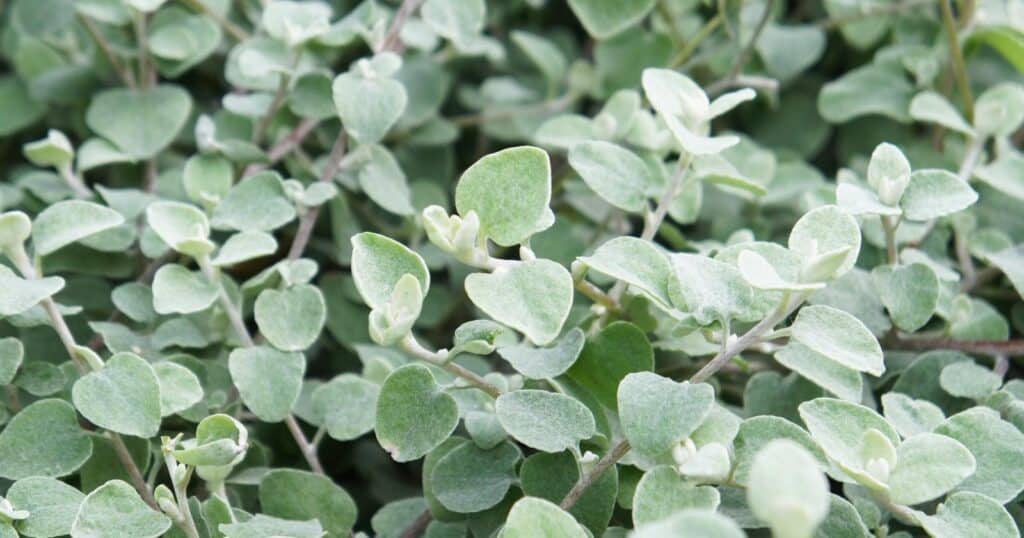
Scientific Name: Helichrysum petiolare
- Plant Type: Perennial
- Origin: Europe
- Plant Size: 18 Inches
- Sunlight Needs: Full Sun
- Hardiness Zone: 9 Through 11
Licorice plants are popular in the Mediterranean and parts of Europe. These plants are often used for making medicinal treatments, cough drops, and candy in many modern facilities. Licorice plants are also known to have been used in ancient Rome and Greece, as well as the Middle Ages for medicinal purposes.
Licorice is a green plant that is easy to grow and requires well-drained soil. These plants can tolerate cold weather and frost but do best in warm and dry conditions.
Living Stones
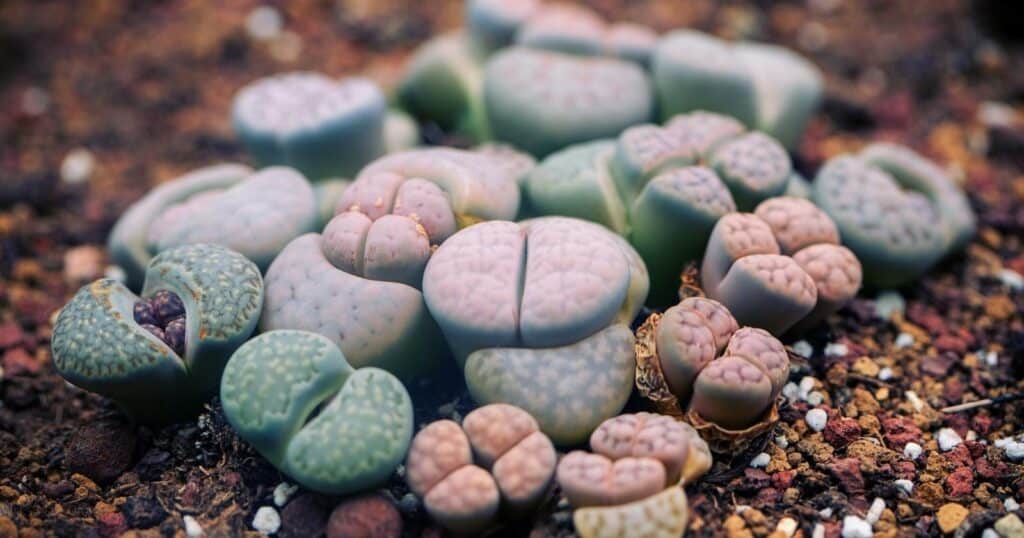
Scientific Name: Lithops
- Plant Type: Perennial
- Origin: Africa
- Plant Size: 1 Inch
- Sunlight Needs: 6 Hours Direct Sun
- Hardiness Zone: 6 Through 9
Living stones are small, stone-shaped succulents that look just like small pebbles or other foliage. Although these succulents do well in direct sunlight, they thrive in partial shade. However, living stones enjoy dry conditions and are heavily drought-resistant. All succulents are drought tolerant because they do not require much watering and can be overwatered easily.
Living stones have evolved to look like stones as a protective mechanism. Now, living stones look like small stones and have varying patterns and designs on their surfaces. Usually, living stones will have a crease down the middle of the surface.
Moss Rose
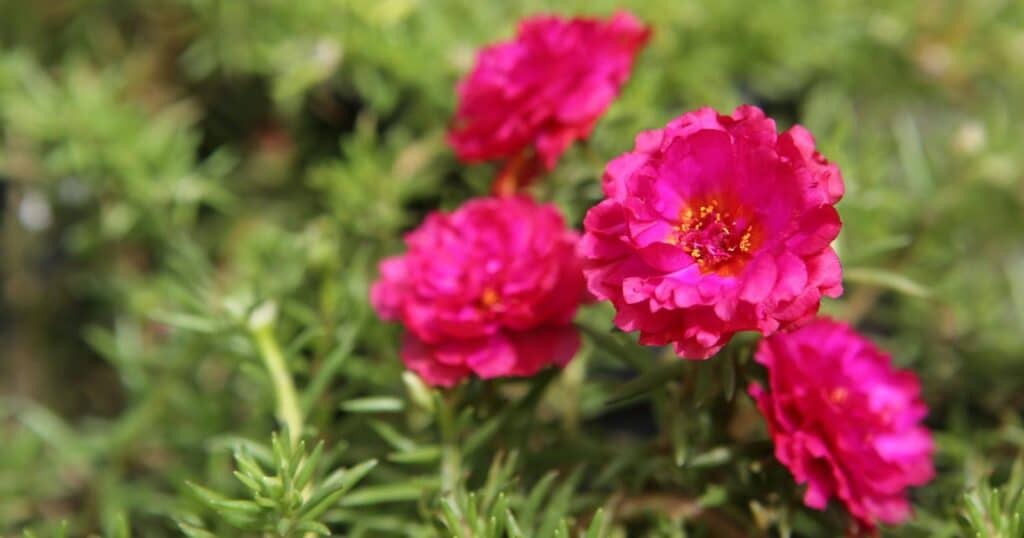
Scientific Name: Portuluca grandiflora
- Plant Type: Annual
- Origin: Uruguay, Brazil, and Argentina
- Plant Size: 12 Inches
- Sunlight Needs: Full Sun
- Hardiness Zone: 2 Through 11
Although Moss Rose is an annual, the flowers and moss will regrow every year and bloom new flowers. Additionally, this plant is herbaceous and is cultivated for many home gardens as an annual plant. However, this plant will need little assistance to regrow with the new season and thus is often mistaken for a perennial.
Oleander
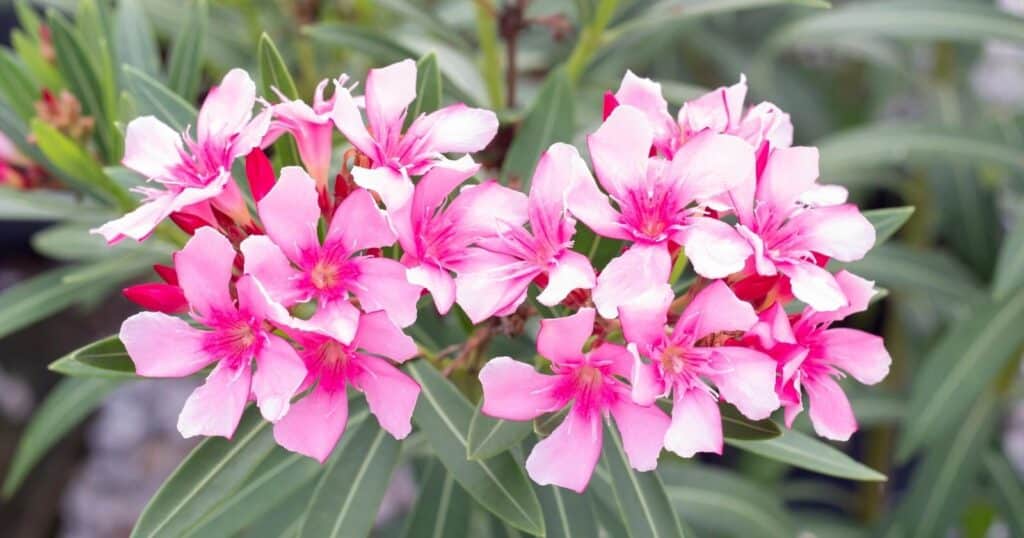
Scientific Name: Nerium oleander
- Plant Type: Perennial
- Origin: Africa and the Mediterranean
- Plant Size: 12 Feet
- Sunlight Needs: Full Sun
- Hardiness Zone: 8 Through 10
Oleander plants are tolerant to heat and survive well in drought-prone areas. They do especially well next to the sea and are often found growing naturally on the coastline. During the winter, Oleander plants will likely die but regrow when the conditions are more suitable.
Oleanders do best in full sun and can handle soil that is not rife with nutrients.
Rosemary
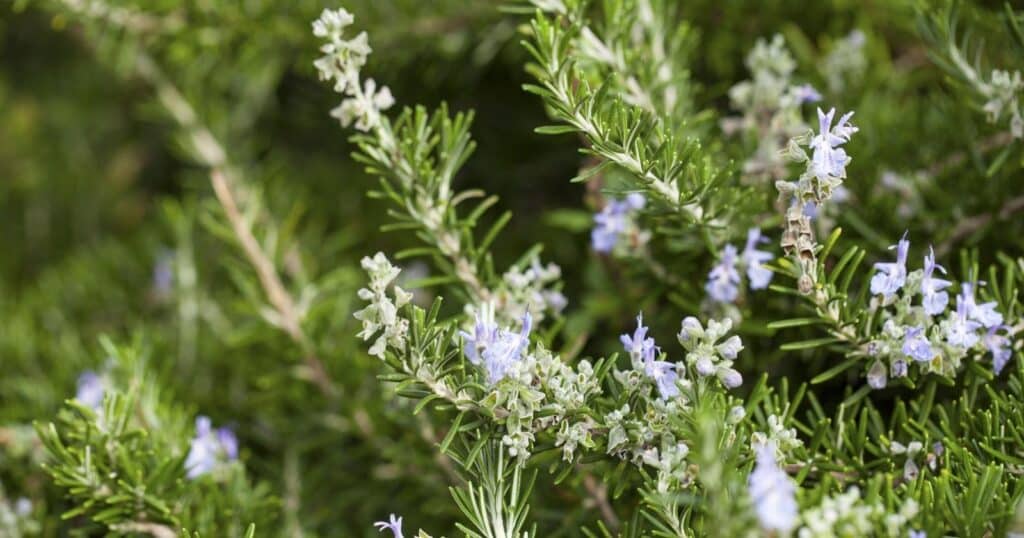
Scientific Name: Rosmarinus officinalis
- Plant Type: Perennial
- Origin: The Mediterranean
- Plant Size: 6 Feet
- Sunlight Needs: Full Sun
- Hardiness Zone: 8 Through 11
Rosemary has been used as a medicinal plant for centuries, beginning in the Mediterranean region. This plant is also used in condiments, foods, beauty products, and cleaning supplies. Rosemary is known to fight inflammation and is an antioxidant. It’s a popular garden herb that can be grown indoors in pots.
Rosemary is characterized by a dull green and white color and grows on tall stalks.
Russian Sage
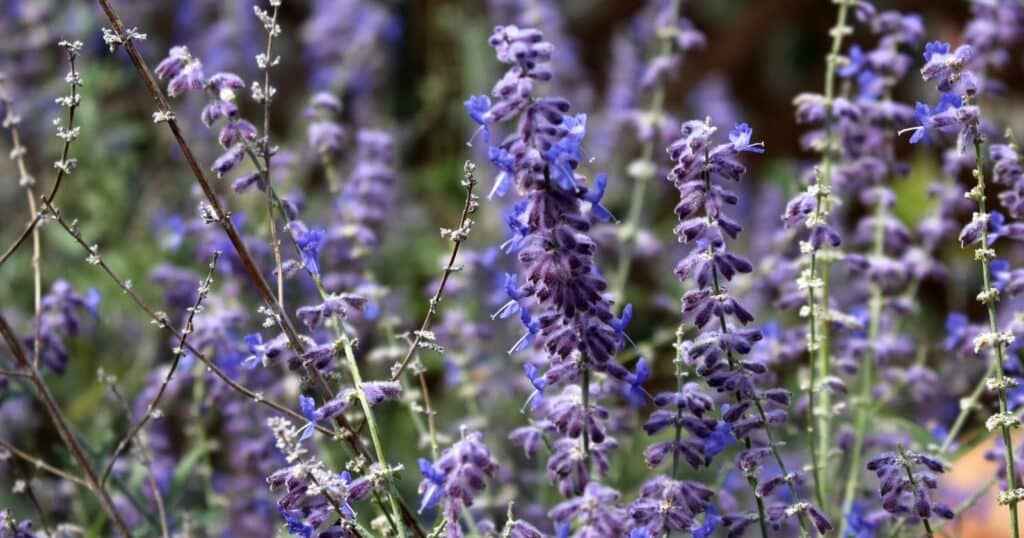
Scientific Name: Perovskia atriplicifolia
- Plant Type: Perennial
- Origin: Asia
- Plant Size: 5 Feet
- Sunlight Needs: Full Sun
- Hardiness Zone: 4 Through 9
A Russian sage plant is low maintenance and requires little effort to keep alive and help it thrive. This plant has seven varieties with different colorations and textures. Some variations have flowers that will attract bees and pests, while others will never attract insects.
This plant is naturally found in Central Asia and at high elevations in Tibet. The name, however, may be confusing as its origin country does not match its name. Russian botanist, Karelin, found this plant and named it around 1840. However, this plant is neither from Russia nor a sage plant.
Sage
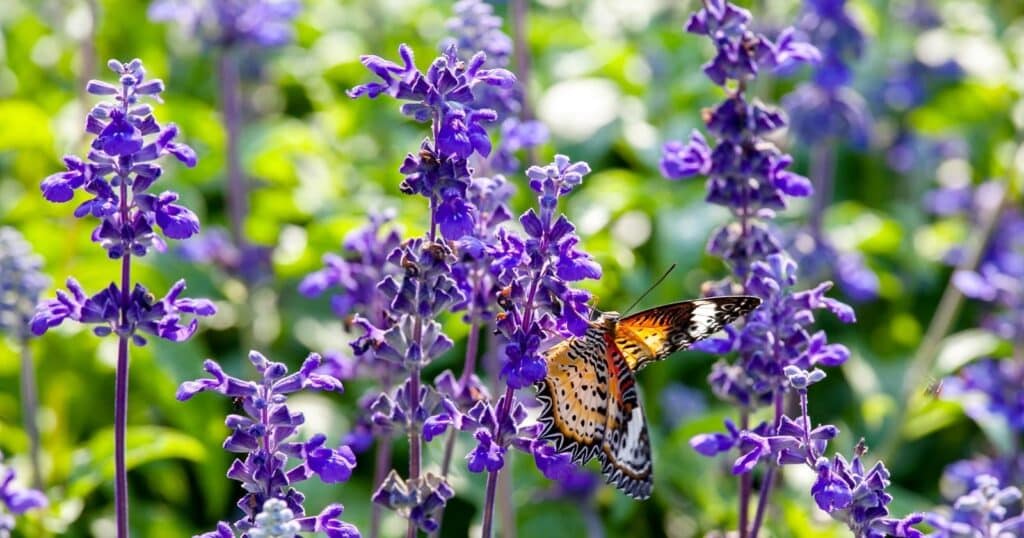
Scientific Name: Salvia officinalis
- Plant Type: Perennial
- Origin: Mediterranean
- Plant Size: 24 Inches
- Sunlight Needs: Full Sun
- Hardiness Zone: 4 Through 11
Sage is an herbaceous perennial that is used for many foods, perfumes, and beauty products. This perennial hails from the Mediterranean, where it was used for medicinal use for centuries. Sage can be dried or used fresh to enhance flavors or help ease the pain of some minor physical ailments. In the middle ages, some healers thought that sage could improve memory and help people think clearer.
Sage grows vibrant purple flowers that can be used to add fragrance to items or create essential oils.
Sea Holly
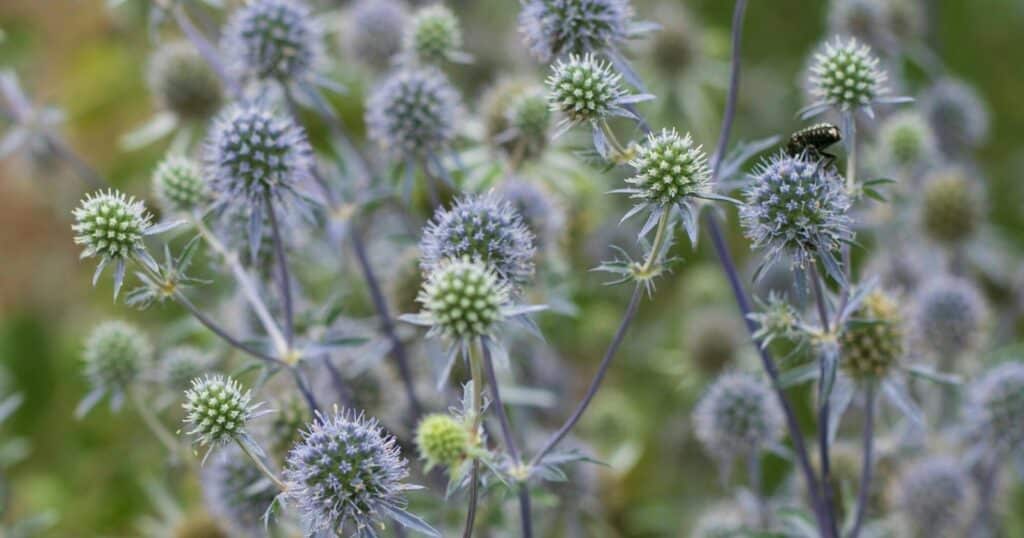
Scientific Name: Eryngium amethystinum
- Plant Type: Perennial
- Origin: Europe and The Mediterranean
- Plant Size: 36 Inches
- Sunlight Needs: Full Sun
- Hardiness Zone: 4 Through 9
Sea Holly plants produce pinecone-like centers for their vibrant blueish-purple flowers. These spikey centerpieces make Sea Holly an unforgettable and unmistakable plant to see in the wild. Sea Holly does well in salty regions and sandy soil. Because of this, Sea Holly grows best on the coastline.
There are several different kinds of Sea Holly:
- Alpine Sea Holly
- Amethyst Sea Holly
- Mediterranean Sea Holly
- Giant Sea Holly
- Flat Sea Holly
- Rattlesnake Master
- Common Sea Holly
Some variations of Sea Holly grow in mountainous regions, like that of the Switzerland alpines. However, most stick close to coastlines and arid areas.
Snow-in-Summer
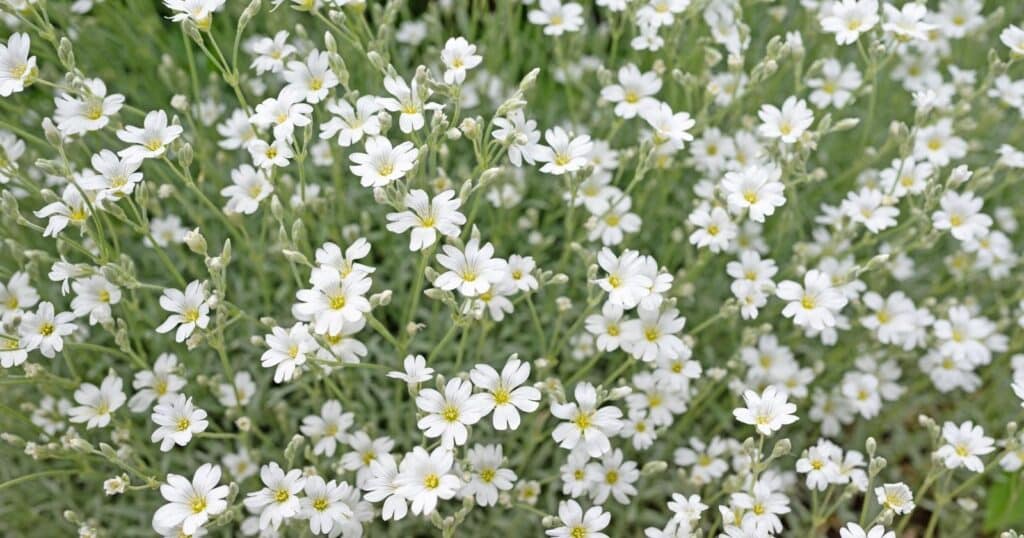
Scientific Name: Cerastium tomentosum
- Plant Type: Perennial
- Origin: Europe
- Plant Size: 12 Inches
- Sunlight Needs: Full Sun
- Hardiness Zone: 3 Through 7
Snow-in-Summer is a flowering plant that is ideal for ground cover. This plant grows quickly and is a member of the carnation family. A Snow-in-Summer plant produces star-shaped and white flowers that are reminiscent of a pile of snow.
These plants are hardy and resistant to drought. Snow-in-Summer flowers enjoy dry conditions and grow best when paired with rock gardens and hillsides. A Snow-in-Summer plant can quickly cover a lot of ground when left alone.
Trumpet Vine
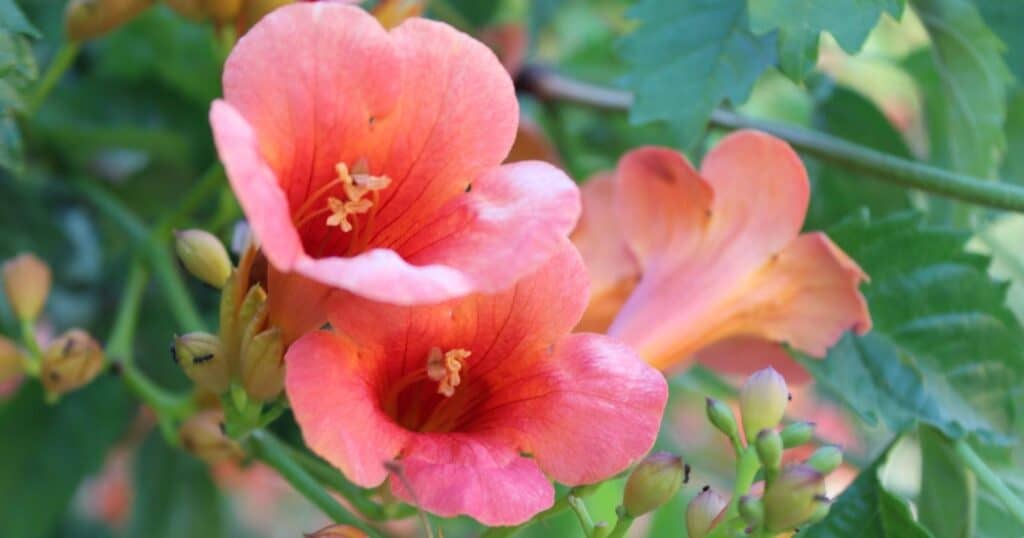
Scientific Name: Campsis radicans
- Plant Type: Perennial
- Origin: China and North America
- Plant Size: Up To 35 Feet
- Sunlight Needs: Full Sun
- Hardiness Zone: 4 Through 9
A Trumpet Vine is a perennial that grows quickly and can grow orangey-red flowers. This vine is ideal for trellises and pergolas. When given proper care, Trumpet Vines can be controlled and will not expand far.
However, home gardeners can sometimes consider Trumpet Vines invasive when they are not tended for several days.
Veronica
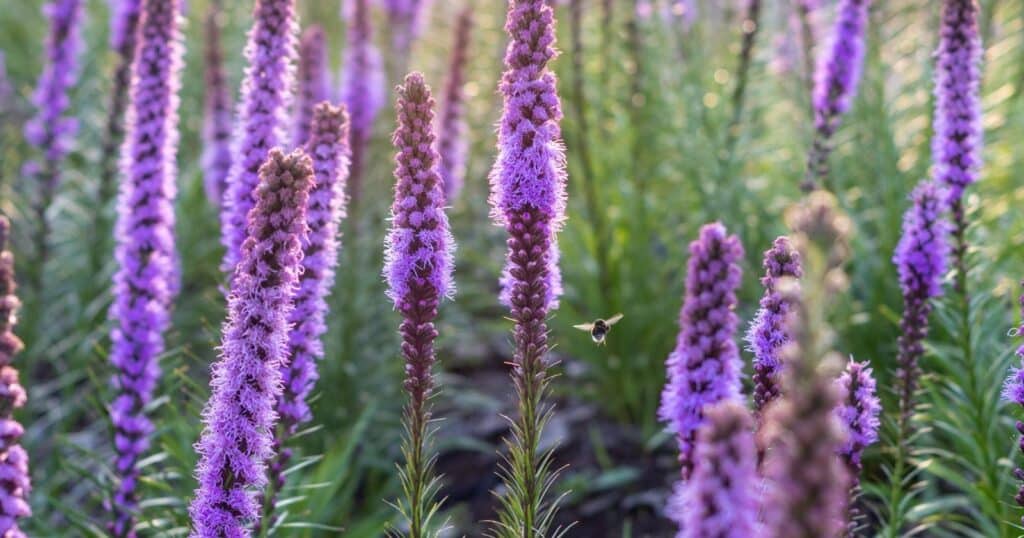
Scientific Name: Veronica spicata
- Plant Type: Perennial
- Origin: Europe and Asia
- Plant Size: 3 Feet
- Sunlight Needs: Full Sun
- Hardiness Zone: 4 Through 8
A veronica plant can tolerate some shade but will need at least six hours of direct sunlight to thrive. These plants do best in dry conditions and do not like to be overwatered. Overwatering a veronica plant can be detrimental to its health and cause the vibrant colors to wither and die.
A veronica plant is characterized by a stunning purple or magenta color. These plants grow upward in stalks that begin as green and slowly gain their color as they mature.
Wild Potato Vine
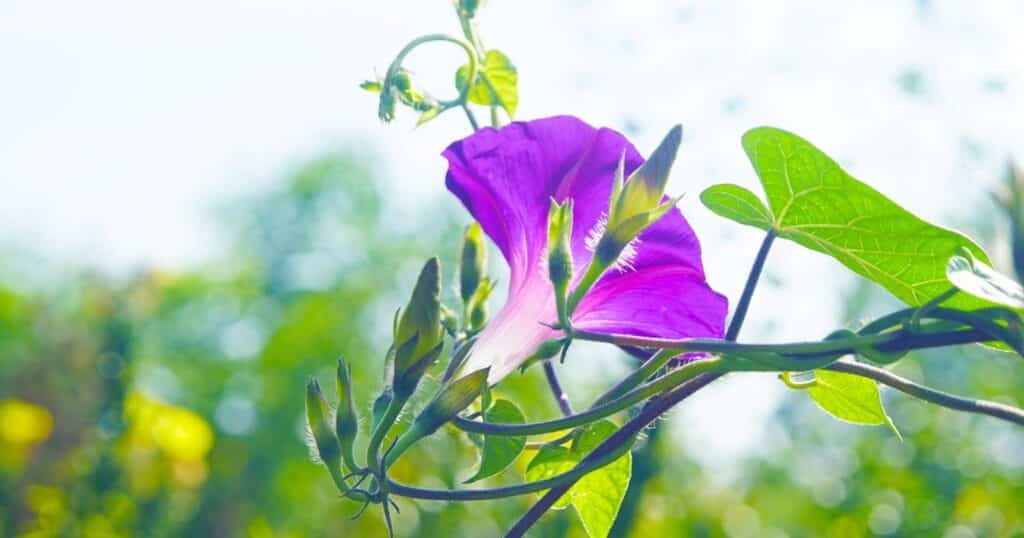
Scientific Name: Ipomea pandurata
- Plant Type: Perennial
- Origin: Eastern and Southern North America
- Plant Size: Up To 30 Feet
- Sunlight Needs: Full Sun
- Hardiness Zone: 6 Through 8
This plant produces a vine and is a herbaceous plant in the Morning Glory family of flowers. A Wild Potato Vine does well in drought-prone areas and can cover a lot of ground. Some vines can spread several feet and insulate the ground and roots of other plants below.
Wild Potato Vines also grow stunning and vibrant white flowers with purple centers. Sometimes the center is a different color.
Yarrow
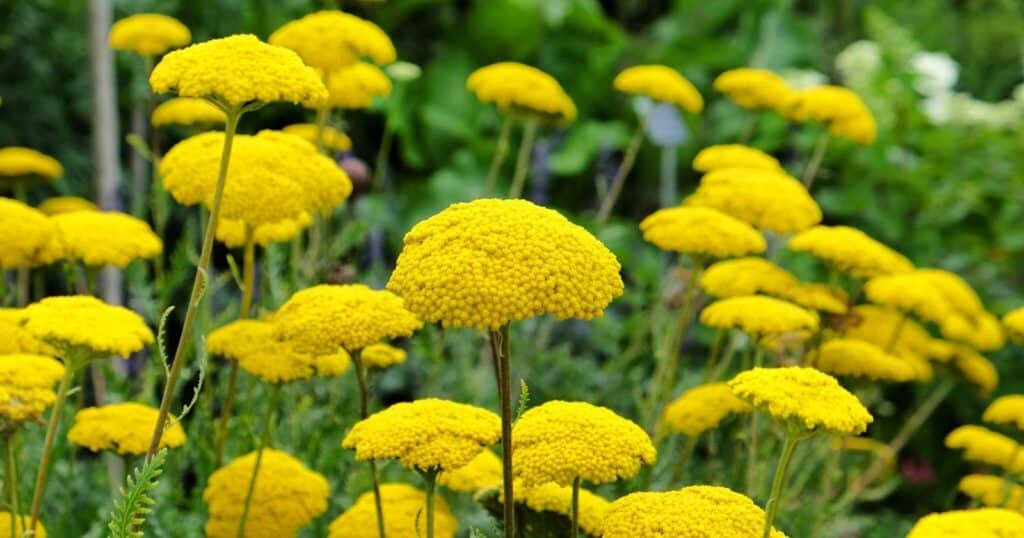
Scientific Name: Achillea millefolium
- Plant Type: Perennial
- Origin: Asia, Europe, and North America
- Plant Size: 4 Feet
- Sunlight Needs: Full Sun
- Hardiness Zone: 3 Through 9
Yarrow plants come in a variety of colors. Much like marigolds, yarrow plants have vibrant and stunning colors and enjoy well-drained soil. These plants provide shade to their roots by forming a canopy of flowers that insulate the plant down below and keep the roots from getting sun-scorched.
A yarrow plant can produce orange, red, pink, purple, and white flowers. Additionally, hybrid colors may occur when plants are kept close together and cross-pollinate.
Wrap Up
Light droughts are common, but severe droughts can be unprecedented and affect millions of people worldwide. In addition to their impact on our quality of life, droughts can also play a major role when it comes to gardening. Areas with rising temperatures or those subject to harsh climate changes can make having a thriving garden difficult, but not impossible.
Plenty of amateur and home gardeners can reap the benefits of a thriving garden when they choose one of the many plants, flowers, shrubs, and succulents listed above. Although some may require more attention than others, all of these plants are resistant to droughts and can thrive in dry conditions or with little water and attention.

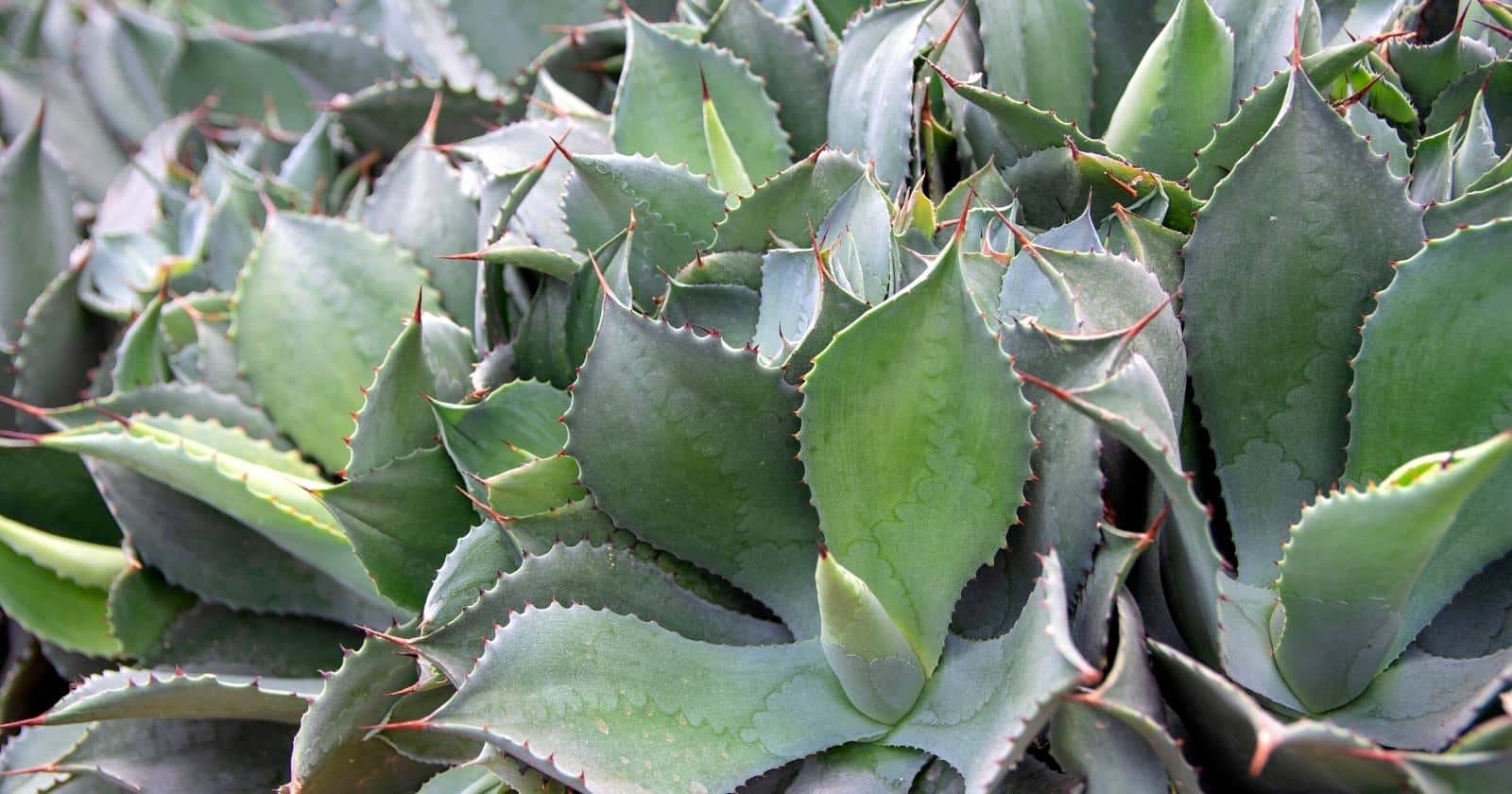
Leave a comment